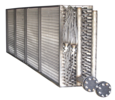Selecting the right standard steam coils and steam distributing coils

As you probably know, there are two types of steam coils: standard steam coils and steam distributing coils. The main difference between these two steam coils is the design and construction – single-tube vs. dual-tube. Steam coils with copper, cupro-nickel, carbon steel, and stainless steel tubes are available to match the temperature requirements and level of corrosion resistance needed. Tube and connection size are combined to limit condensate retention in the coil, preventing water hammer while delivering even distribution of steam.
Standard Steam Coils
Steam is a simple and economical heating choice, and steam coils are used in a wide variety of HVAC systems. These single-tube coils are used for above-freezing air temperatures. Standard steam coils have either same end connections or opposite end connections. Steam coils operate at higher temperatures than other types of coils, so only 1 or 2 rows are usually required.
Steam moves from the boiler to the point of use and releases energy at a constant temperature when it condenses. As air moves through the fin contact area, it is heated by steam moving through the tubes. It then condenses and leaves the coil as a liquid. Standard steam coils are normally used?in warmer climates where the air entering the system stays above freezing. If much colder air passes across a standard steam coil, it can freeze, making the steam distributing coil a better option.
Steam Distributing Coils
While standard steam coils have single-tube construction, steam distributing coils have tube-in-tube (dual-tube) construction. Steam distributing (sometimes referred to as “non-freeze”) coils, contain a perforated inner tube that runs the length of the coil, so wherever you see an outside tube or header, there’s a hidden tube and header inside. As the steam turns to condensate travelling down the inner tube, the condensate is released through the perforations (holes) to the outer tube. Steam that doesn't turn into condensate is released through the end of the open inner tube to the outer tube. The outer tube has no return bends, so the condensate that is under pressure has nowhere to go but back down the outer tube toward the manifold where the steam originated. The steam in the inside tubes keeps the condensate in the outside tubes from freezing, even when air passes across the steam distributing coil at less than 32° F. Unfortunately, under extreme cold weather conditions, it is possible for even “non-freeze” steam distributing coils to freeze.
Contact us at 855-Coil-Now or sales@emergentcoils.com for assistance in choosing the best steam coils and steam distributing coils for your needs.
